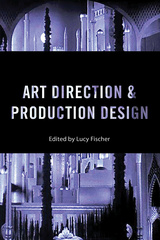
220 pages, 6 x 9
30 black-and-white photos, 2 tables
Hardcover
Release Date:31 Oct 2017
ISBN:9780813564302
Directing
Edited by Virginia Wright Wexman
SERIES:
Behind the Silver Screen Series
Rutgers University Press
When a film is acclaimed, the director usually gets the lion’s share of the credit. Yet the movie director’s job—especially the collaborations and compromises it involves—remains little understood.
The latest volume in the Behind the Silver Screen series, this collection provides the first comprehensive overview of how directing, as both an art and profession, has evolved in tandem with changing film industry practices. Each chapter is written by an expert on a different period of Hollywood, from the silent film era to today’s digital filmmaking, providing in-depth examinations of key trends like the emergence of independent production after World War II and the rise of auteurism in the 1970s. Challenging the myth of the lone director, these studies demonstrate how directors work with a multitude of other talented creative professionals, including actors, writers, producers, editors, and cinematographers.
Directing examines a diverse range of classic and contemporary directors, including Orson Welles, Tim Burton, Cecil B. DeMille, Steven Soderbergh, Spike Lee, and Ida Lupino, offering a rich composite picture of how they have negotiated industry constraints, utilized new technologies, and harnessed the creative contributions of their many collaborators throughout a century of Hollywood filmmaking.
The latest volume in the Behind the Silver Screen series, this collection provides the first comprehensive overview of how directing, as both an art and profession, has evolved in tandem with changing film industry practices. Each chapter is written by an expert on a different period of Hollywood, from the silent film era to today’s digital filmmaking, providing in-depth examinations of key trends like the emergence of independent production after World War II and the rise of auteurism in the 1970s. Challenging the myth of the lone director, these studies demonstrate how directors work with a multitude of other talented creative professionals, including actors, writers, producers, editors, and cinematographers.
Directing examines a diverse range of classic and contemporary directors, including Orson Welles, Tim Burton, Cecil B. DeMille, Steven Soderbergh, Spike Lee, and Ida Lupino, offering a rich composite picture of how they have negotiated industry constraints, utilized new technologies, and harnessed the creative contributions of their many collaborators throughout a century of Hollywood filmmaking.
A rare and useful contribution to the history of Hollywood film directors – their varied working conditions, their talented collaborators, and their sometimes limited but more often significant contributions to film art.
This fascinating collection of essays by established field historians goes further than any publication to date to challenge the mythologies that have grown up around the auteur director. This is achieved most notably by historical overview of the actual work of the studio director as it has evolved from 1895 to the present.'
A rare and useful contribution to the history of Hollywood film directors – their varied working conditions, their talented collaborators, and their sometimes limited but more often significant contributions to film art.
This fascinating collection of essays by established field historians goes further than any publication to date to challenge the mythologies that have grown up around the auteur director. This is achieved most notably by historical overview of the actual work of the studio director as it has evolved from 1895 to the present.'
VIRGINIA WRIGHT WEXMAN is Professor Emerita of English and art history at the University of Illinois at Chicago. She is the author of many books including Women and Experimental Filmmaking.
Acknowledgments ix
Introduction Virginia Wright Wexman 1
1. THE SILENT SCREEN, 1895–1927
Cecil B. DeMille Shapes the Director’s Role Charlie Keil 26
2. CLASSICAL HOLLYWOOD, 1928–1946
The Company Man and the Boy Genius William Luhr 48
3. POSTWAR HOLLYWOOD, 1947–1967
On Dangerous Ground Sarah Kozloff 68
4. THE AUTEUR RENAISSANCE, 1968–1980
A Culture of Rebellion Daniel Langford 92
5. THE NEW HOLLYWOOD, 1981–1999
Three Case Studies Thomas Schatz 110
6. THE MODERN ENTERTAINMENT MARKETPLACE, 2000–Present
Revolutions at Every Scale J. D. Connor 137
Academy Awards for Directing 155
Notes 161
Selected Bibliography 185
Notes on Contributors 189
Index 191
Introduction Virginia Wright Wexman 1
1. THE SILENT SCREEN, 1895–1927
Cecil B. DeMille Shapes the Director’s Role Charlie Keil 26
2. CLASSICAL HOLLYWOOD, 1928–1946
The Company Man and the Boy Genius William Luhr 48
3. POSTWAR HOLLYWOOD, 1947–1967
On Dangerous Ground Sarah Kozloff 68
4. THE AUTEUR RENAISSANCE, 1968–1980
A Culture of Rebellion Daniel Langford 92
5. THE NEW HOLLYWOOD, 1981–1999
Three Case Studies Thomas Schatz 110
6. THE MODERN ENTERTAINMENT MARKETPLACE, 2000–Present
Revolutions at Every Scale J. D. Connor 137
Academy Awards for Directing 155
Notes 161
Selected Bibliography 185
Notes on Contributors 189
Index 191






